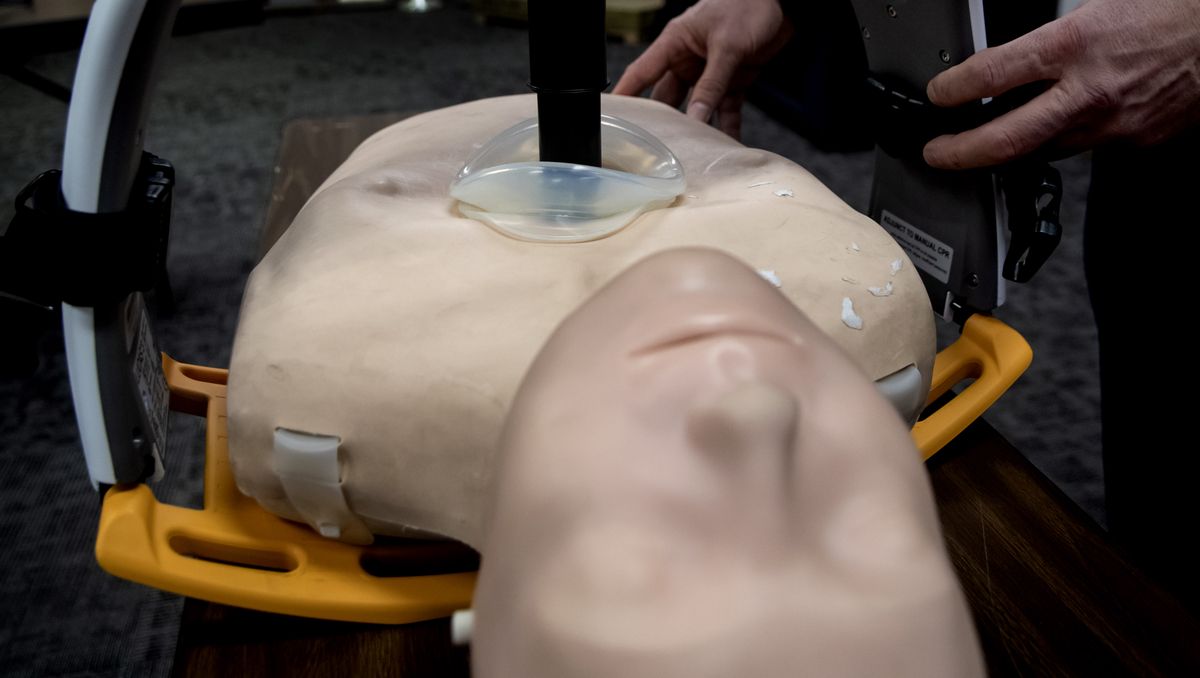New CPR devices put to the test: Fire District 8, Valley Fire acquire systems to streamline resuscitation

Spokane County Fire District 8 is getting ready to roll out devices that can perform CPR on patients, reducing the number of firefighters and paramedics needed to treat them.
The district purchased six Lucas 3 machines manufactured by Stryker with a $90,000 grant from Spokane County using CARES Act funding. There will be one device on each engine, one used for training and one to serve as a backup. Crews are training on the devices now, and they should be on the trucks in the first week of March, said Medical Services Officer and paramedic Tom Chavez.
Each device comes in a hard-sided carrying case. A small backboard is slid under the patient and the machine is hooked to the backboard, so the machine and the patient don’t move, Chavez said. This eliminates the need to move the patient to a hard, flat surface before beginning CPR.
“This can be done anywhere,” Chavez said. “We don’t have to move the patient, which we typically have to do.”
The device arches over the patient’s chest and a large suction cup is lowered to the chest. “It automatically comes down and senses where the chest is at,” he said.
At the touch of the button, a piston performs the CPR motions to compress the patient’s chest. The goal in chest compressions is to depress the chest by 2 inches, Chavez said. The machine depresses the chest by 2.1 inches. “That’s to make sure the heart fully compresses,” he said.
Firefighters in District 8 typically use the “pit crew” CPR method. Two or three engines usually respond to every heart attack call to provide between eight and 11 people to perform CPR.
Typically, there is one person at the patient’s head managing the airway and performing breaths, another checking the femoral pulse, another managing any IV and two to three others cycling in and out every two minutes to perform the chest compressions.
“You get tired after a minute and a half,” Chavez said. “It is hard. It’s 100 times a minute.”
Using the machine cuts down on the number of people needed to treat the patient. “With this machine, we don’t have to have those extra two or three people and there’s no pausing,” Chavez said.
Using fewer people is a benefit when crews have to worry about COVID-19, said Fire Chief Lonnie Rash. “The less people we have in that 6-foot range, even though we’re in full PPE, reduces that exposure,” Rash said.
But using the machine doesn’t mean that fewer firefighters will respond to heart attack calls. “It won’t reduce our response,” Rash said. “It will get crews back into service more quickly.”
The machine has several different settings. It can perform continuous CPR, sets of 30 chest compressions broken up by pauses for two breaths, or a pattern of six chest compressions followed by a pause for one breath.
Chavez said he likes the Lucas 3 device because it can stay attached to the patient while he or she is in the ambulance. If the heart stops again, medics can simply restart the machine instead of having the ambulance pull over so they can resume hands on CPR, he said.
“It’s continuity of care, all the way through,” he said.
Rash said his district chose the Lucas 3 devices because they are compatible with the Stryker cardiac monitors that the district already owns.
SVFD chooses different system
Other districts in the area are moving forward with CPR devices as well. The Spokane Valley Fire Department considered the Lucas 3 device, but decided to use a different one, said paramedic RW Pegau. Their testers preferred the Zoll AutoPulse device, which uses chest straps instead of a piston to perform chest compressions.
Pegau said their key issue with the Lucas 3 device was a concern that it wouldn’t work properly if the patient was at an incline, which would happen while they were carried down stairs on a backboard, he said. The Lucas device was also top heavy in those situations, he said.
The Zoll system includes three components: a cardiac monitor, an AutoPulse CPR device and a ResQPOD portable ventilator. The system will be rolled out slowly, one component at a time, over the next several months, Pegau said. Crews are training on the cardiac monitors, which cost $40,000 each. “The training requirement is not simplistic,” he said.
The department used a $1.8 million CARES Act grant from Spokane County to buy the Zoll system, including 20 cardiac monitors, 12 AutoPulse CPR devices and eight ResQPODs.
“The save rate, with all three of these devices used, was incredible,” Pegau said.